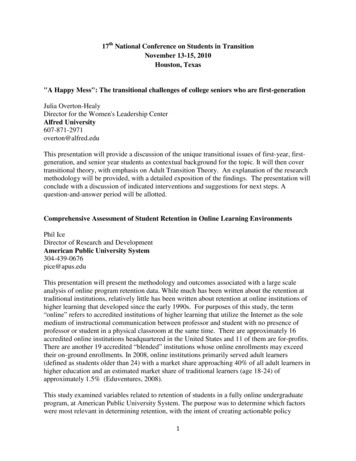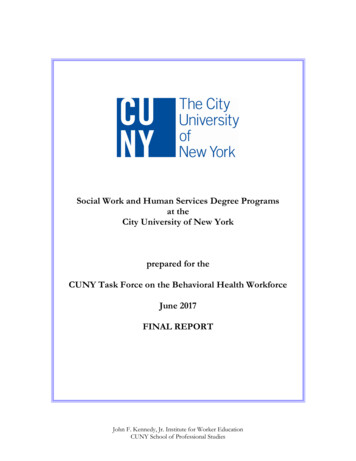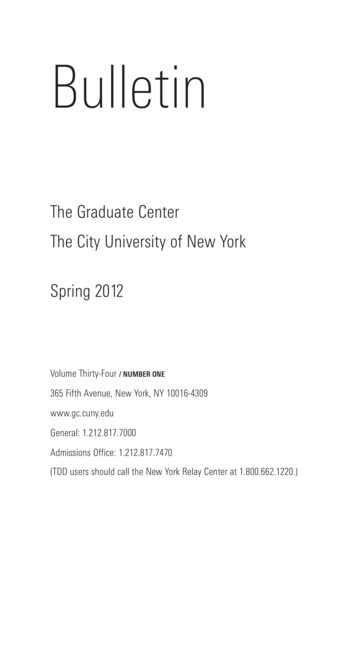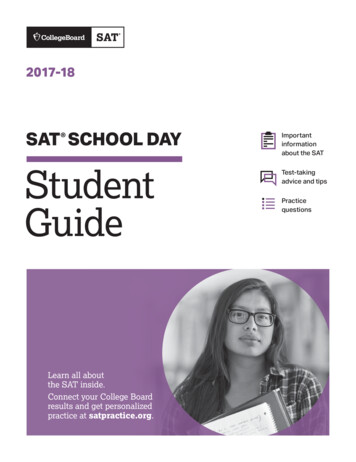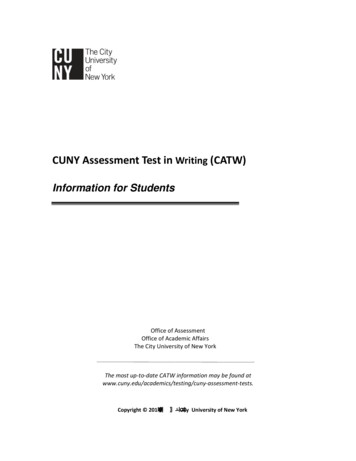
Transcription
CUNY Assessment Test in Writing (CATW)Information for StudentsOffice of AssessmentOffice of Academic AffairsThe City University of New YorkThe most up‐to‐date CATW information may be found ‐tests.Copyright 201ϮdŚĞ City University of New York
Information for StudentsCUNY Assessment Test in Writing1. What is the CUNY Assessment Test in Writing (CATW)?The CUNY Assessment Test in Writing (CATW) is a standardized writing test that measuresyour ability to do college-level writing in English and assesses your readiness for introductorycollege courses.The learning skills taught in first-year college courses are reflected in the CATW. In the test youare required to read, understand, and respond to a passage of 250-300 words by identifying key ideas within the reading passagewriting a brief summary of the key ideas in the readingdemonstrating basic critical thinking in response to these key ideasidentifying a key idea in the reading passage and presenting a clearly written responseto that ideawriting an essay that is well organized and shows connections between ideassupporting ideas with relevant personal experience, readings, schoolwork, and/orother sources of informationdemonstrating competence in sentence construction, sentence variety, and wordchoicedemonstrating correct usage, grammar, and mechanicsYou will have 90 minutes to complete the test. You may bring a non-electronic dictionary to thetest (a paperback dictionary is recommended), bilingual if preferred.2. What kind of test is it? Multiple choice? Problem-solving? Reading? Essay?The CATW is designed to test students’ ability to think and write in English, similar to theway they will be asked to think and write throughout their college careers. It consists of areading passage (the text) and writing instructions. Students must read the passage andinstructions and then write an essay responding to the passage while following theinstructions. Students have 90 minutes to complete the exam. There are no multiple-choice orproblem-solving questions.A sample of the test, the scoring rubric, and student responses follow this Information forStudents.CATW–Information for Students1
3. Who has to take the test? Why do I have to take the test?Associate ProgramsCandidates for admission to an associate program do not have to show they are skillsproficient to be admitted. However, entering students who are not proficient based on theSAT, ACT or Regents tests must take the appropriate CUNY Assessment Tests. Onceenrolled in an associate program, students will be required to take one or more remedialcourses to build their skills in any areas in which they have not met the proficiencyrequirement. Students usually cannot begin a full program of college-level work in anassociate program until they have achieved proficiency in reading, writing and math.Baccalaureate ProgramsCandidates for admission to a bachelor's degree program must show that they are proficientin reading, writing and math to be admitted.If the CUNY Assessment Tests show that you are not skills proficient, you should speak toan admissions counselor to get more information about the best choice for you.WritingStudents are considered proficient in writing if they can document any one of the following:SAT I verbal score of 480 or higher or critical reading score of 480 or higherACT English score of 20 or higherN.Y. State English Regents score of 75 or higherCUNY Assessment Tests: Reading Test score of 70 or higher and Writing Testscore of 56 or higher.To be eligible to register for the first college-level composition course, students must beproficient in both reading and writing.For more information, go to ts/faqs.html.4. Is this a new test? How is it different from the old test?The CATW is a new writing test. It will be used for the first time on October, 1, 2010. TheCATW replaces the CUNY/ACT essay.The CATW differs from the CUNY/ACT essay in several ways. While both tests askstudents to prepare a writing sample and both assess students’ writing ability, the new testmore closely represents the kinds of writing students do in their introductory college-levelCATW–Information for Students2
courses. It differs from the CUNY/ACT essay by drawing on students’ critical thinking skillsin response to a reading selection.The CATW asks students to explain and support their ideas about the reading passage,organize their thinking and writing, and employ the elements of standard, written English,including appropriate sentence construction and word choice, as well as correct grammar,usage, and mechanics.Students have 90 minutes to complete the new test.5. How is the test scored? What is a passing score? How do I find out about myscore?The CATW uses an analytic scoring guide, called a scoring rubric, to evaluate student writingsamples. Each test is scored independently by two faculty raters and both raters assign scores infive categories. Scores may range from 1 to 6 points in each category.The Five Scoring Categories1. “Critical Response to the Writing Task and Text”: This category emphasizes your abilityto complete the writing task and to demonstrate understanding of the main ideas in thereading text, using critical analysis, and integrating your own ideas and experiences torespond to the main ideas in the text.2. “Development of Writer’s Ideas”: In this category you are evaluated on your ability todevelop your ideas (for example, by using summary, narrative, or problem/solution) in aclear and organized way. Your response should include both general statements andspecific details and examples. Specific references to the text must be included with these details andexamples.3. “Structure of the Response”: This category evaluates your ability to organize ideas into acohesive essay that supports a central focus, or thesis. The structure of your essay isevaluated for evidence of logical connections between ideas and the use of transitions toconvey these connections.4. “Language Use: Sentences and Word Choice”: This category evaluates the degree towhich you demonstrate sentence control and variety in sentence structure. Thiscategory also evaluates your ability to use appropriate vocabulary to make your ideasclear.5. “Language Use: Grammar, Usage, Mechanics”: This category evaluates your ability tofollow the conventions of standard American English language use in terms of grammarand mechanics, so that your meaning is clear.CATW–Information for Students3
CATW Analytic Scoring RubricCritical Response to theWriting Task and theText6x A thoughtful and skillfulresponse to the task effectivelyintegrates a critical discussionof ideas in the text withrelevant elements of theZULWHU¶V UHDGLQJ DQG experience.x The discussion demonstrates athorough understanding of themain ideas and the complexityof ideas in the text.5x The response effectivelyintegrates a criticaldiscussion of ideas in the textwith relevant elements of theZULWHU¶V UHDGLQJ DQG experience.x The discussion demonstratesa good understanding of themain ideas and thecomplexity of ideas in thetext.4Development of the :ULWHU¶V Ideasx Ideas are fully developed, andapproaches to development (e.g.,summarizing, evaluating,narrating) are used skillfully toVXSSRUW DQG FRQYH\ WKH ZULWHU¶V ideas throughout the response.x Reasons and specific details andexamples from the text and from theZULWHU¶V UHDGLQJ DQG H[SHULHQFH DUH used effectively to develop ideas.x Ideas are well developed, andapproaches to development (e.g.,summarizing, evaluating, narrating)are usually used skillfully to supportDQG FRQYH\ WKH ZULWHU¶V LGHDV x Reasons and specific details andexamples from the text and from theZULWHU¶V UHDGLQJ DQG H[SHULHnce areusually used effectively to developideas.x The response competentlyintegrates a criticaldiscussion of ideas in the textwith relevant elements of theZULWHU¶V UHDGLQJ DQG experience.x Most ideas are competentlydeveloped and approaches todevelopment (e.g., summarizing,evaluating, narrating) arecompetently used to support andFRQYH\ WKH ZULWHU¶V LGHDV x The discussion consistentlydemonstrates anunderstanding of the mainideas and of some of thecomplexity in the text.x Reasons and specific details andexamples from the text and fromWKH ZULWHU¶V UHDGLQJ DQG H[SHULHQFH are competently used to developideas.Structure of the Responsex Organization demonstrates awell-designed progression ofLGHDV WKDW VXSSRUWV WKH ZULWHU¶V central focus and the clarity ofideas throughout the response.x Sophisticated, effective use oftransitions conveys relationshipsamong ideas throughout theresponse.x Organization generallydemonstrates a clear plan withsome progression of ideas thatVXSSRUWV WKH ZULWHU¶V FHQWUDO focus and the clarity of theZULWHU¶V LGHDV x Transitions clearly conveyrelationships among ideasthroughout the response.x An organizational structure isevident and competentlyVXSSRUWV WKH ZULWHU¶V centralfocus and the clarity of theZULWHU¶V ideas. Relevant ideas aregrouped together, and there maybe some evidence of progressionof ideas.x Though often simple andobvious, transitions are usuallymade to convey relationshipsamong ideas.Language Use: Sentencesand Word Choicex Sentences are consistentlywell controlled, witheffective variety in structure.x Word choice is sophisticated,precise, and effectivelyconveys the complexity of theZULWHU¶V LGHDV WKURXJKRXW WKH response.x Sentences are usually wellcontrolled, and there is someeffective variety in structure.x Word choice is usually specificand usually effective inFRQYH\LQJ WKH ZULWHU¶V LGHDV x Most sentences demonstratecompetent control, and there isenough structural variety tosupport the clarity of theZULWHU¶V ideas.Language Use:Grammar, Usage, andMechanicsx Though there may be a fewerrors in grammar, usage,and mechanics, strongcommand of language isapparent, and meaning isclear throughout theresponse.x Though there may be a fewerrors in grammar, usage, andmechanics, good commandof language is apparent, andmeaning is usually clear.x Language use is competent.Grammar, usage, andmechanics are generallycorrect, and meaning isusually clear.x Word choice is somewhatgeneral but clearly conveysmeaning.4Copyright 2012 The City University of New York
3C ritical Response to the W ritingT ask and the T extDevelopment of the :ULWHU¶V ,GHDVx The response integrates someideas from the text with somerelevant elements of theZULWHU¶V UHDGLQJ DQG experience, but may do so inan uneven manner.x Development of ideas is generalor uneven, but approaches todevelopment sometimes supportWKH FODULW\ RI WKH ZULWHU¶V LGHDV x The response demonstratessome understanding of themain ideas in the text, butunderstanding is uneven,superficial, or incomplete.2x There is little integration ofideas from the text withHOHPHQWV RI WKH ZULWHU¶V reading and experience.x The response demonstrates aweak understanding of themain ideas in the text.1x There is minimal, if any,integration of ideas from thetext with elements of theZULWHU¶V UHDGLQJ DQG experience.x The response demonstrateslittle, if any, understanding ofthe main ideas in the text.x The response uses some reasonsand specific details and examplesfrom the text and from theZULWHU¶V reading and experience todevelop ideas.x Development of ideas is weak, andthere may be little use of relevantapproaches to development.x If present, reasons, details, andexamples from the text and fromWKH ZULWHU¶V UHDGLQJ DQG H[SHULHQFH are brief, general, inadequatelydeveloped, or not clearly relevant.Structure of the Responsex The response uses a basic oruneven organizational structurethat sometimes supports theZULWHU¶V FHQWUDO IRFXV DQG clarityof ideas. For the most part,relevant ideas are groupedtogether.L anguage Use: Sentences andWord C hoiceL anguage Use: G rammar,Usage, and M echanicsx Sentence control is uneven,but there is some structuralvariety to support the clarity ofideas.x Command of language isuneven. Grammar, usage, andmechanics are generallycorrect, but some errors aredistracting and mayoccasionally impedeunderstanding.x Word choice is simple butusually clear enough toconvey meaning.x Some simple and obvioustransitions are used to conveyrelationships among ideas.x The response shows an attemptto create a central focus and toput related ideas together, butrelationships among ideas maybe unclear.x Few, if any, transitions are usedto convey relationships amongideas.x There is minimal or nodevelopment of ideas and little, ifany, use of relevant approaches todevelopment. There may be an attempt togroup related ideas together, butthe main focus of the response isunclear.x If any reasons, details, andexamples from the text or from theZULWHU¶V UHDGLQJ DQG H[SHULHQFH DUH present, these elements are brief,general, undeveloped, or irrelevant. Transitions are rarely used.x Sentences demonstrate weakcontrol, and there is little, ifany, sentence variety toprovide clarity.x Word choice is simple, andsometimes meaning is notclear.x Sentences demonstrateminimal or no control.x Word choice is oftenunclear and often obscuresmeaning.x The response demonstrates aweak command of language.Grammar, usage, andmechanics are sometimescorrect, but errors are oftendistracting, and some impedeunderstanding.x The response demonstratesminimal command oflanguage. Grammar, usage,and mechanics are oftenincorrect, and errorsfrequently impedeunderstanding.5Copyright 2012 The City University of New York
You should notice that the scoring rubric describes levels of performance in each of thescoring categories. You can get anywhere from 6 points from a rater for a very strongperformance to 1 point for a very weak performance.Scores in the 1 & 2 point range identify weak responses to the assignment; scores in the 3 &4 point range identify mid-level responses; scores in the 5 & 6 point range identify very goodor superior responses.Your response will receive a Weighted Total score on the CATW. Weighted Total scores arecalculated by adding up the individual rater scores across the five scoring dimensions;however, scores in the three content dimensions – Critical Response, Development of Ideas,and Structure of Response – are weighted twice as much as those in the two language usedimensions – Sentence and Word Choice, and Grammar; and Usage and Mechanics. Forexample, if your response is rated 4 in each dimension by both raters, the total weightedscore would be 2(4 4) 2(4 4) 2(4 4) (4 4) (4 4) 64.A passing score on the CATW is 56, which can be obtained by getting a combination of 3’sand 4’s in each of the scoring categories: 2(3 4) 2(3 4) 2(3 4) (3 4) (3 4) 56.Of course, there are other combinations of scores that will add up to a 56, but overall youshould think of aiming your writing level at getting at least a 4 from at least one of the ratersin each of the scoring categories and having no one give you a 2 in any category.You may obtain detailed information about your score from your college’s TestingOffice.6. How will my test score affect my choice of programs and classes?Exit from Remedial and ESL Course SequencesAll students registered in their college's top-level course in Reading, Writing, or ESL willtake the test(s) at the end of the semester. Students who do not pass the test(s) will not beable to begin college composition until they pass both the Reading and WritingAssessment Tests.Faculty at each college decide the requirements for passing each top-level remedial,developmental, or ESL course. Sometimes, passage of the skills test is required to passthe course; sometimes it is not. In any case, the University expects that students who passthe reading and writing tests will move directly to College Composition I at their nextregistration.7. What happens if I fail the test?RetestingGenerally, students must receive at least 20 hours of instruction between retests. Theymay not be retested more than two times during a semester. Specific rules apply forworkshops and summer and winter immersion.For more information, go to ts/faqs.htmlCATW–Information for Students6
8. How can I prepare for the test? What resources are there to help me toprepare for the test?The University has test preparation resources available to help you prepare for the CATs.Each College in the University has a testing information center with resources to helpincoming and continuing students prepare for the CATs. To find out about a specificcollege’s test preparation resources, go to your college’s Testing Office.For more information, go to s/resources.html9. Are there any sample tests I can review?There are sample tests and practice exercises following this Information for Students.Copyright 201Ϯ The City University of New YorkCATW–Information for Students7
CUNY Assessment Test in Writing (CATW)Practice Exercises for StudentsOffice of AssessmentOffice of Academic AffairsThe City University of New YorkThe most up‐to‐date CATW information may be found ‐tests.Copyright 2010 The City University of New York
Practice Exercises for StudentsHow to Understand the Reading and Get StartedBefore you start to write your response, we recommend you spend 20 minutes reading andunderlining significant ideas and 10 minutes planning and prewriting. The more time you spendunderstanding the reading and getting ideas before you write, the easier it will be to write.1. Below is a practice reading, “How to Do One Thing at a Time.” Read it and underlinesignificant ideas. Make notes of how you plan to organize your response.How to Do One Thing at a TimeBy now, we all know that multi-tasking can be a losing proposition. Talking on thephone while driving? Dumb idea. Texting while driving? Really dumb idea. But evenseemingly harmless multi-tasking—like chatting with a friend while sending out an officee-mail—isn’t as harmless or efficient as we’d like to believe. A recent article publishedin the science journal NeuroImage revealed that when we attempt demanding taskssimultaneously, we end up doing neither as well as we should because our brains havecognitive limits.What’s more, we’re also less efficient after we’ve shut down e-mail and turned offour phones. In a recent experiment at Stanford University, a group of students wasasked to spend 30 minutes simultaneously compiling a music playlist, chatting, andwriting a short essay. A second group focused on each task individually for 10 minuteseach. Afterward, they were given a memory test. The single-taskers did significantlybetter than their multi-tasking peers.“A tremendous amount of evidence shows that the brain does better when it’sperforming tasks in sequence rather than all at once,” says Clifford Nass, Ph.D., aprofessor of communication at Stanford University. “We still don’t know the long-termeffects of chronic multi-tasking, but there’s no question we’re bad at it, and it’s bad forus.”Many experts believe, however, that it’s possible to repair your power ofconcentration. Through solutions such as yoga and acupuncture, experts believe wecan break our multi-tasking habit and sharpen our focus.Adapted from Women’s Health Magazine, May 2010CATW–Practice Exercises for Students1
Below is an example of how a student annotated the reading and planned a response. Compareyour annotations with the example. Did you underline the same sentences? Notice how thisstudent made a T‐chart to organize the ideas.2.CATW–Practice Exercises for Students2
How to Develop Your ResponseIn the Writing Directions for the CATW assignment, you are asked to “develop your essay byidentifying one idea” and explaining its significance. You are also told to support your ideaswith evidence or examples from “what you have read, learned in school, and/or personallyexperienced.” Below is a portion of a response to the passage, “How to Do One Thing at aTime.”1. Read the partial response below and identify the idea the writer has chosen to focus on.How does the writer develop the idea? Does the writer use examples and details fromhis/her reading, previous school learning, or personal experience? Notice also what thewriter does in the first paragraph.Sample ResponseThe article says we’re less efficient even after we stop emailing and get off thephone. This conclusion was based on an experiment where students were asked todo three things at once for 30 minutes—create a playlist of music, chat on email,and write an essay. A second group was asked to do the same three things but oneat a time, for ten minutes each. At the end, students in the second groupperformed better on a memory test than those who tried to multitask.I am not surprised the second group performed better. I can imagine chattingon email at the same time I’m fooling around with an iPod, but I certainly couldn’twrite an essay as well. Writing an essay takes (me) a lot of time and concentration.I once had a teacher who made us practice writing 10-minute essays so we would beready for a timed test. We did it every class for a couple of weeks before thetest, and it was effective for training the class to concentrate and write fastenough to do a 50 minute test. He called it “special case” writing, something to dofor a timed test to get ideas down quickly. He never said it was the way to reallywrite. Writing an essay involves reading, thinking, and revising, not while doingother things. That’s why we have libraries and quiet study areas. I envy the personwho can write an essay while doing other things—but only if the person gets an A onthe essay. Otherwise, I’ll stick to my slow, single-minded approach.Students who think they can multitask are in for a big surprise when they get todifficult subjects and demanding assignments. This carries beyond school to manyactivities in life, driving, parenting, getting promoted for doing a job well .[Note: This response is not finished. It needs further development and an ending.]CATW–Practice Exercises for Students3
2. Below is the sample response showing its development. Refer to the code below.Development of “Sample Response”The article says we’re less efficient even after we stop emailing and get offthe phone. This conclusion was based on an experiment where students wereasked to do three things at once for 30 minutes—create a playlist of music,chat on email, and write an essay. A second group was asked to do the samethree things but one at a time, for ten minutes each. At the end, studentsin the second group performed better on a memory test than those whotried to multitask.2I am not surprised the second group performed better. 3I canimagine chatting on email at the same time I’m fooling around with an iPod,but I certainly couldn’t write an essay as well. Writing an essay takes (me) alot of time and concentration. 4I once had a teacher who made us practicewriting 10-minute essays so we would be ready for a timed test. We did itevery class for a couple of weeks before the test, and it was effective fortraining the class to concentrate and write fast enough to do a 50 minutetest. He called it “special case” writing, something to do for a timed test toget ideas down quickly. He never said it was the way to really write. Writingan essay involves reading, thinking, and revising, not while doing other things.That’s why we have libraries and quiet study areas. 5I envy the person whocan write an essay while doing other things—but only if the person gets an Aon the essay. Otherwise, I’ll stick to my slow, single-minded approach.6Students who think they can multitask are in for a big surprisewhen they get to difficult subjects and demanding assignments. This carriesbeyond school to many activities in life, driving, parenting, getting promotedfor doing a job well .1Code:1Summary of passage2Personal response overall to summary3One idea writer wants to develop4Personal experience that develops idea5Conclusion/lesson of personal experience6Continuing developmentCATW–Practice Exercises for Students4
How to Demonstrate Connections Between IdeasIn the CATW analytic scoring rubric, the category “Structure of the Response” looks at how well youorganize your response and “demonstrate connections between ideas.” In other words, it isimportant that your sentences and paragraph connect one to the next, so the reader can follow yourthinking. You don’t want the reader to fall into a hole between sentences or paragraphs.As an example, here are two sets of sentences: A and B. In which set are the two connected?Explain your answer.A.1It is safe to say that advertisements are a person’s guideline in life. 2After the IndustrialRevolution almost everyone wants to transfigure into a modernized individual.B.1Although it may be irritating to see an ad come on in the middle of your favorite show, theinformation supplied by that ad may not be available to you anywhere else. 2Corporations createads to keep us updated on what is new.Answer: The sentences in B are connected. The second sentence provides a specific detail/exampleas a restatement of the first. It “opens up” the first sentence. In contrast, the sentences in A seemunconnected. You cannot be sure of the connection, and the meaning is not clear.Further Examples1. Look at the Sample Student Paper #1, paragraphs 5 and 6 below. (The complete response is onpp. 11‐12) Notice how the writer connects each sentence and paragraph to the next one.I suppose I’ve written all of this to show, as the author points out, how advertisingpermeates our entire society. There’s a chemical term which I think would apply to this,the Point of Saturation. Basically, when you have mixed so much solute (e.g. sugar)into a solvent (e.g. water) to the point that the solvent can hold no more of the solute (Inmy example, any further sugar crystals would just drop to the bottom), it had reached itsP.O.S. Somehow, I think this aptly describes our minds when it comes to advertising. Iwonder if we can take much more without any adverse effects. The author starts todelve into this when they mention how children watch ads in the classroom, and in thelast sentence [kid singing the song]. Actually, most advertisements target children.They want children to see the ads, desire the product, and then beg their parents to buyit. As an additional bonus, this constant message of consumerism at such a young agewill ensure that many children wanting (overspending) all sorts of products intoadulthood. To illustrate, one study found that Polish families spend the most family timewhen shopping together. Maybe facts like this, and the rising number of families inperpetual credit card debt, can be taken as evidence of the adverse effects ofadvertising.All things considered, we suffer.We are victims of a malady known asoverabundant advertising. Maybe one day, a commission will be formed to limit theamount, and location of advertisements companies can use. But until then, one thing iscertain. It is only a matter of time before we all begin hearing that Oscar Meyer song inour heads.Explanation: Paper #1, paragraph 5 begins with a summarizing sentence: “I suppose I’vewritten all of this to show, as the author points out, how advertising permeates our entiresociety.” This sentence connects everything written before, as well as the reading, to thiswriter’s restatement of the main point. Paper #1, paragraph 6 begins: “All thingsconsidered, we suffer.” Once again, the writer reminds us of all that’s been written (“Allthings considered”) and draws a conclusion.2. Look at Paper #4, paragraph 3 below to see if the writer is successful in connecting one sentenceto the next. (The complete Paper # 4 response is on pp.16‐17.) Read paragraph 3 and pick outCATW–Practice Exercises for Students5
The media itself sends us thousands of marketing messages per day. Themedia explores on the issue of obesity America is suffering with but in the nextminutes a fast food restaurant commercial is acknowledged. Followed by videogame commercials leading into a weight loss commercial. Advertisementsdoesn’t have a valid message because its advocating to eat while playing videogames or watching TV. Although on the contrary it is advised to lose weightbecause the previous commercials could cause medical problems. The vastamount of advertisements shown are implying on how we should live are livesand most of the population is agreeing with this patetic lifestyle.Sample Revision: Paper #4, Paragraph 3The media sends thousands of inconsistent and contradictory messages everyday tellingus how to live our lives. One minute, the media explores the issue of obesity that manyAmericans suffer from, but in the next, it shows a commercial about a fast food restaurant.A commercial of a video game is followed by a weight loss commercial. The messageappears to advocate eating while playing video games or watching TV. On the contrary, itcould be advising us to lose weight because the previous commercials show what causesmedical problems. Most of the population that takes in these commercials ends upagreeing with this pathetic lifestyle.What do you think of this revision? Do the sentences seem connected? What sentence wouldyou say controls the paragraph? As you review your own writing, check to see that yoursentences and ideas are connected and lead from one to another.CATW–Practice Exercises for Students6
How to Write a Summary for the CATW ResponseIn the Writing Directions for the CATW response, you are required to “summarize the passage in yourown words, stating the author’s most important ideas.” It is important that you do not copy theauthor’s ideas directly from the passage when writing your summary. Your goal in this part of theCATW writing task is to demonstrate how well you understand the reading passage, using your ownwords.Write the following key id
The CUNY Assessment Test in Writing (CATW) is a standardized writing test that measures . problem-solving questions. A sample of the test, . UNY Assessment Tests: Reading Test score of 70 or higher and Writing Test . score of 56 or higher. To be eligible to register for the first college-level composition course, students must be .

